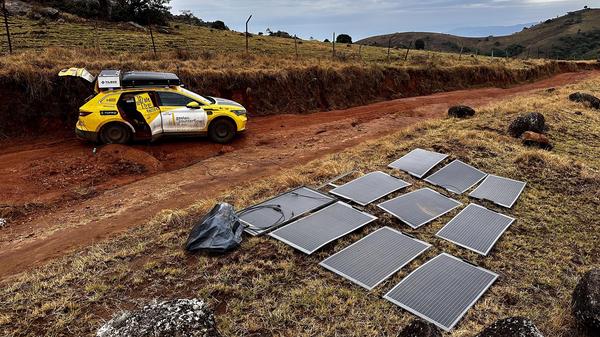Feature
Busting electric car myths on an epic African adventure
How a Dutch couple overcame range anxiety and more besides by driving a Skoda Enyaq across Africa
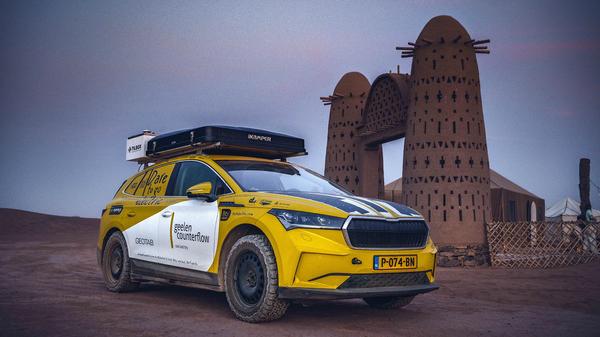

Words by: Dan Trent
Published on 13 March 2024 | 0 min read
If worries about charging infrastructure, reliability and battery degradation have put you off buying a new or used electric car the experiences of Dutch couple Renske Cox and Maarten van Pel and their Skoda Enyaq can hopefully reassure you there’s nothing to be scared of. On the basis if you can successfully drive an electric car across a continent where chargers can be literally thousands of miles apart you’re probably going to be OK for the school run or commute over here.
Overall, their story is one of both incredible personal determination and also vindication an ‘everyday’ electric car like their Skoda Enyaq is capable of way more punishment than you might think. One example? When they eventually did reach a dealership capable of running a battery health check it came back as performing exactly as you would expect for any other Enyaq of equivalent age and mileage. And in all those thousands of miles of driving the only failure was in the final stretch, when one of the rear dampers in the suspension finally gave out. Not bad given the extra weight the car was carrying and the state of the roads they were driving on! But how did they do it? And, most of all, how on earth do you drive across some of the wildest and most remote terrain on the planet in an electric car when there’s nowhere to plug in and charge it up?
Overall, their story is one of both incredible personal determination and also vindication an ‘everyday’ electric car like their Skoda Enyaq is capable of way more punishment than you might think. One example? When they eventually did reach a dealership capable of running a battery health check it came back as performing exactly as you would expect for any other Enyaq of equivalent age and mileage. And in all those thousands of miles of driving the only failure was in the final stretch, when one of the rear dampers in the suspension finally gave out. Not bad given the extra weight the car was carrying and the state of the roads they were driving on! But how did they do it? And, most of all, how on earth do you drive across some of the wildest and most remote terrain on the planet in an electric car when there’s nowhere to plug in and charge it up?

The power of the sun
Africa may not have an abundance of electric car charging points. But it does have a lot of sunshine. And the idea they might be able to keep their car moving by charging it on solar power was the key to unlocking this epic EV adventure.
Having tested the theory that a portable array of flexible solar panels would be enough to power the Enyaq the rest of the preparations were relatively straightforward. Modifications to the car may look dramatic with the addition of a roof-top tent and fitting essentials like a 50-litre water tank, fridge and induction stove, the latter two powered by additional solar panels on the car and a separate battery. But the mechanical changes to the car went no further than fitting chunky off-road tyres and tougher springs to cope with the extra weight and handle the lumpy terrain. True, these did cost in terms of range. But when you’re driving on unmade roads and some of the local wildlife could literally eat you for breakfast if you break down it was a decision that made itself!
Having tested the theory that a portable array of flexible solar panels would be enough to power the Enyaq the rest of the preparations were relatively straightforward. Modifications to the car may look dramatic with the addition of a roof-top tent and fitting essentials like a 50-litre water tank, fridge and induction stove, the latter two powered by additional solar panels on the car and a separate battery. But the mechanical changes to the car went no further than fitting chunky off-road tyres and tougher springs to cope with the extra weight and handle the lumpy terrain. True, these did cost in terms of range. But when you’re driving on unmade roads and some of the local wildlife could literally eat you for breakfast if you break down it was a decision that made itself!
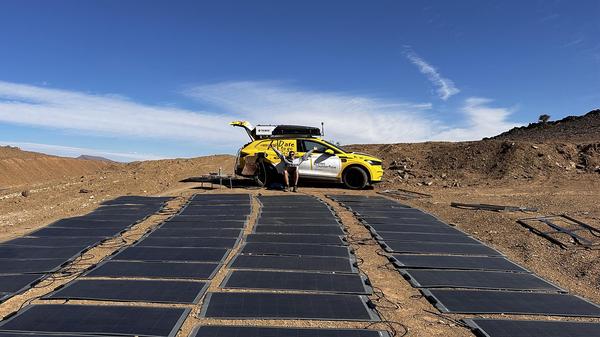
All about the range
Freed from the need to plan their route from charger to charger, Renske and Maarten could then concentrate on enjoying the journey, and learning the tricks necessary to complete a self-sufficient trip across Africa in an electric car.
While the idea of charging by solar looks attractive there are realities to consider. The 60 flexible panels that stash away in the boot are each about the size of a beach towel, and originally designed to be used in rooftop installations rather than for portable charging. But they stood up to the challenge, with no issues from the constant unpacking and packing, a job that takes mere minutes. “Finding the best places to charge became kind of a sport,” laughs Renske, explaining they would plan their stops according to weather apps and locations like open spaces on hills to maximise the charge from the sun’s rays. Charging took a whole day at a time, which would typically be enough to put 40kWh into the battery, or about half its total capacity. This would then do them for the next 125-mile leg, an optimum cruising speed just shy of 40mph the best for maximising range. Impressively they scored an average efficiency of around 3.4 miles per kWh of battery charge, which is about the same as we got driving a standard Enyaq here in the UK! With plenty of time to crunch the data on charging stops Renske says as much as 24 per cent of their total energy used in the 24,000-mile trip was from regenerative charging under ‘braking’, while Maarten told us they made plenty of use of the adaptive cruise control. “There were actually some really good roads, and the cruise control and lane keeping worked really well on those long sections,” he says.
While the idea of charging by solar looks attractive there are realities to consider. The 60 flexible panels that stash away in the boot are each about the size of a beach towel, and originally designed to be used in rooftop installations rather than for portable charging. But they stood up to the challenge, with no issues from the constant unpacking and packing, a job that takes mere minutes. “Finding the best places to charge became kind of a sport,” laughs Renske, explaining they would plan their stops according to weather apps and locations like open spaces on hills to maximise the charge from the sun’s rays. Charging took a whole day at a time, which would typically be enough to put 40kWh into the battery, or about half its total capacity. This would then do them for the next 125-mile leg, an optimum cruising speed just shy of 40mph the best for maximising range. Impressively they scored an average efficiency of around 3.4 miles per kWh of battery charge, which is about the same as we got driving a standard Enyaq here in the UK! With plenty of time to crunch the data on charging stops Renske says as much as 24 per cent of their total energy used in the 24,000-mile trip was from regenerative charging under ‘braking’, while Maarten told us they made plenty of use of the adaptive cruise control. “There were actually some really good roads, and the cruise control and lane keeping worked really well on those long sections,” he says.

As a rule the air-con was kept switched off, a common trick electric car drivers looking for maximum range will be familiar with. In this case it was as much so they could acclimatise to the ambient temperatures, though, on the basis this is more comfortable than constantly getting in and out of a freezing cold car on a hot day. “We had a heat reflecting film on the windows that helped,” says Renske, “but at around 40km/h [25mph] the airflow with the windows down was usually perfectly comfortable.”
While they charged as much as possible with the solar panels they did, on occasion, plug into the local grid. Given the power supply in some places wasn’t all that this could take longer than solar, and aware that an electric car was drawing more power than the local infrastructure was often used to they always paid their way.
While they charged as much as possible with the solar panels they did, on occasion, plug into the local grid. Given the power supply in some places wasn’t all that this could take longer than solar, and aware that an electric car was drawing more power than the local infrastructure was often used to they always paid their way.
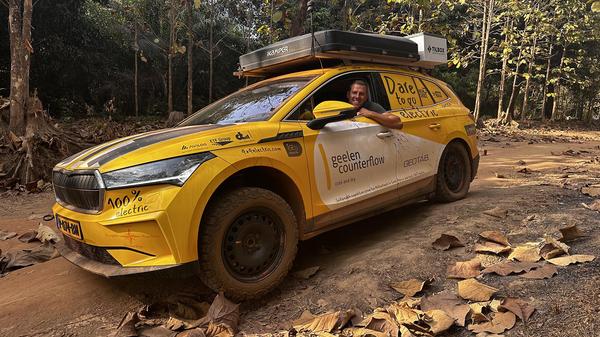
Proving the point
While it sounds a more committed road trip than the average Renske and Maarten are seemingly relaxed about what they’ve achieved with this adventure. They’ve certainly demonstrated even an everyday electric car is a lot tougher than you might imagine, and they’re both full of praise for the way the Enyaq coped with the challenges.
“We met other overlanders on our trip driving conventional vehicles and they were stopping to service their engines on a regular basis,” laughs Renske. “Apart from rotating the tyres around from time to time we just had to top up the windscreen washer fluid and that was it!” She’s full of praise for the engineering of the Skoda’s VW-sourced foundations as well. “We did hit the bottom of the car on the ground a few times,” she says, “but when we eventually got the Skoda on a ramp in Capetown we could see there’s a protection plate on the bottom that is part of the standard car. You could see there was about a 20mm space between the plate and the battery, and some of the dents were big enough that it was nearly touching in places. But it the way the car is built definitely saved the battery, and without that kind of build quality we’d never have made it.”
“We met other overlanders on our trip driving conventional vehicles and they were stopping to service their engines on a regular basis,” laughs Renske. “Apart from rotating the tyres around from time to time we just had to top up the windscreen washer fluid and that was it!” She’s full of praise for the engineering of the Skoda’s VW-sourced foundations as well. “We did hit the bottom of the car on the ground a few times,” she says, “but when we eventually got the Skoda on a ramp in Capetown we could see there’s a protection plate on the bottom that is part of the standard car. You could see there was about a 20mm space between the plate and the battery, and some of the dents were big enough that it was nearly touching in places. But it the way the car is built definitely saved the battery, and without that kind of build quality we’d never have made it.”
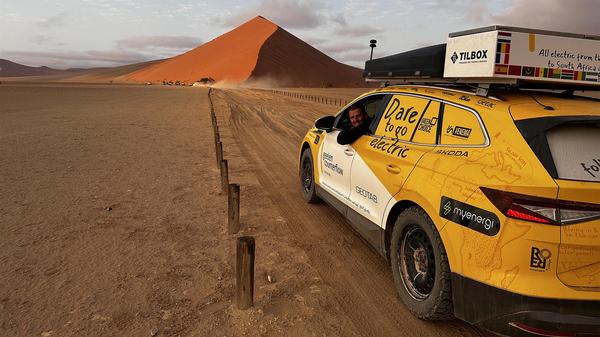
Perhaps not the kind of punishment most owners will be dishing out. But good to know if you’re in the market for an Enyaq, or indeed any of the cars like the VW ID.3, ID.4, ID.5 and ID.Buzz, the Cupra Born or the Audi Q4 e-tron that share the same fundamental structure, battery and motors.
Solar power may be a rather committed choice for the everyday electric car driver, meanwhile. But Renske and Maarten have proved the point about sustainable long-distance travel, while also demonstrating many of the more common fears about living with electric cars are unfounded. However adventurous your driving!
Solar power may be a rather committed choice for the everyday electric car driver, meanwhile. But Renske and Maarten have proved the point about sustainable long-distance travel, while also demonstrating many of the more common fears about living with electric cars are unfounded. However adventurous your driving!
